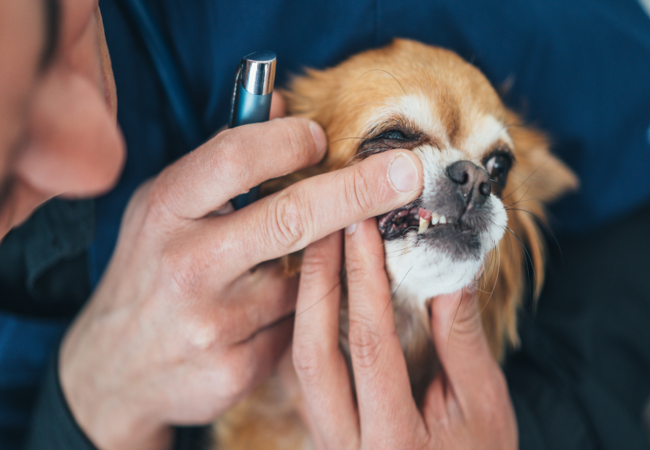Tooth Root Abscess in Dogs in 2025 Vet Guide: Urgent Care & Healing 🦷🐾

In this article
Tooth Root Abscess in Dogs in 2025 Vet Guide: Urgent Care & Healing 🦷🐾
By Dr. Duncan Houston BVSc
Hello caring pet parents! I’m Dr Duncan Houston BVSc. In this comprehensive 2025 guide, we'll explore tooth root abscesses in dogs: from causes and symptoms, to diagnostic approaches, treatment options (root canal or extraction), at-home care, recovery, prevention, and how Ask A Vet,can support both you and your pup ❤️.
1. What Is a Tooth Root Abscess?
A tooth root abscess is a painful, localized bacterial infection at the tip of a tooth root that forms a pocket of pus. Often resulting from pulp necrosis secondary to tooth fracture or severe periodontal disease, abscesses may erode bone and may even drain internally or externally.
2. What Causes It?
Common causes include:
- Tooth fractures: Hard chewing (bones, antlers, nylon toys) can crack enamel and dentin, exposing pulp to bacteria.
- Slab fractures: Often affecting carnassial teeth; expose root canals and lead to abscess formation.
- Periodontal disease: Allows bacteria to track along root surfaces and infect deeper structures.
3. Most Commonly Affected Teeth
- Upper fourth premolars (carnassials)
- Lower first molars
- Canine (fang) teeth
These are large, heavily used teeth prone to cracks and pulp exposure that may progress to abscesses.
4. Signs & Symptoms 🩺
Dogs with a tooth root abscess may show subtle or obvious signs like:
- Bad breath (halitosis)
- Dropping food or reluctant chewing
- Pawing at the face or rubbing it on the ground
- Switching chewing sides
- Swelling under the eye or along jaw
- Draining tracts on face or gums
- Facial pain, head sensitivity
- General signs—fever, lethargy, reduced appetite.
5. Why Prompt Treatment Matters
- Prevents bone loss, facial deformity, and blindness from orbital infection.
- Reduces systemic spread—abscess bacteria can reach heart valves or brain in rare cases.
- Relieves severe pain and suffering.
6. How Is It Diagnosed?
- History & physical—look for swelling, draining tracts, oral pain.
- Oral examination—may require sedation due to pain.
- Dental X-rays are essential—they reveal periapical lucency (darkening around root).
- Lab work—CBC and chemistry to assess infection, metabolism.
7. Treatment Options
7a. Medical Therapy
Antibiotics and anti-inflammatory drugs provide initial relief but don't eliminate the abscess :
- Broad-spectrum antibiotics based on oral flora
- Pain relief: NSAIDs ± opioids
- Facial swelling may temporarily subside, but underlying infection persists.
7b. Definitive Treatment
Only two curative options exist :
- Root canal therapy (endodontics): Removes infected pulp, disinfects canals, obturates, and seals. Ideal for functionally important teeth. Crown may be placed later. Prognosis: excellent with specialist intervention.
- Extraction: More commonly chosen, especially by general practitioners. The entire tooth (including roots) is removed, often under anesthesia, followed by bone smoothing and suturing. Discharge same-day.
7c. Post-Treatment Management
- Analgesics and NSAIDs
- Soft or soaked food for 5–7 days.
- Antibiotics—usually 7–14 days
- Follow-up X-ray for root canal cases (3–6 months, then annually).
- Recheck for extraction site healing at 1–2 weeks.
8. Prognosis & Outcomes
- Dogs generally improve within 48–72 hours after definitive treatment.
- Root canal: potential lifetime retention of tooth.
- Extraction: dogs adapt well; chewing rebalanced to other teeth.
- Untreated abscess: risk of chronic draining sinus, bone loss, orbit spread, eye issues, systemic illness.
9. Home Care & Monitoring After Treatment
- Soft diet for 5–7 days
- No chewing on hard toys during early healing
- Maintain oral hygiene—daily brushing, dental chews, water additives
- Regular dental exams every 6–12 months or per your vet’s advice
10. Prevention Strategies
- Watch chewing habits—avoid antlers, real bones, hard plastics.
- Offer safe chew toys—rubber or nylon alternatives.
- Regular oral exams for early tooth cracks or wear.
- Maintain dental hygiene—brushing, chews, professional scaling.
11. Supporting You & Your Dog – Ask A Vet💡
- Ask A Vet: 24/7 access for guidance on pain signs, wound monitoring, and feeding adjustments. Perfect for post-treatment checks.
12. Emotional Care for You & Your Pup ❤️
Watching your pet go through pain and treatment can be overwhelming. Ask A Vet provides emotional support and reassurance during tough moments.aim to help by easing daily care needs. Find comfort in pet-parent communities—you are not alone.
13. Final Thoughts
Tooth root abscess in dogs is a significant, painful condition—but fully manageable with fast identification and correct treatment. Choosing root canal therapy or extraction under professional care brings rapid relief and lasting oral health. Supporting home care, preventive habits, and use of Ask A Vet, services keeps your companion pain-free and thriving for years to come 🐶✨.
— Dr Duncan Houston BVSc
For ongoing expert care, visit AskAVet.com and download the Ask A Vet app today!






